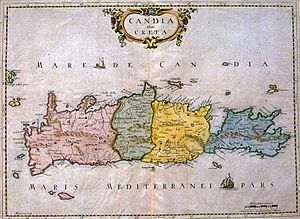Cretan War (1645-1669)
| Cretan War (Fifth Ottoman–Venetian War) |
|||||||||
|---|---|---|---|---|---|---|---|---|---|
| Part of the Ottoman–Venetian Wars | |||||||||
 A Venetian map of Crete. |
|||||||||
|
|||||||||
| Belligerents | |||||||||
|
Maniots |
Barbary States |
||||||||
| Commanders and leaders | |||||||||
|
|
|
||||||||
The Cretan War (Greek: Κρητικός Πόλεμος, Turkish: Girit'in Fethi) or War of Candia (Italian: Guerra di Candia, Serbo-Croatian: Kandijski rat), is the name given to the Fifth Ottoman–Venetian War, a conflict between the Republic of Venice and her allies (chief among them the Knights of Malta, the Papal States and France) against the Ottoman Empire and the Barbary States, because it was largely fought over the island of Crete, Venice's largest and richest overseas possession. The war lasted from 1645 to 1669 and was fought in Crete and in numerous naval engagements and raids around the Aegean Sea, with Dalmatia providing a secondary theater of operations.
Although most of Crete was conquered by the Ottomans in the first few years of the war, the fortress of Candia (modern Heraklion), the capital of Crete, resisted successfully. Its prolonged siege, "Troy's rival" as Lord Byron called it, forced both sides to focus their attention on the supply of their respective forces on the island. For the Venetians in particular, their only hope for victory over the larger Ottoman army in Crete lay in successfully starving it of supplies and reinforcements. Hence the war turned into a series of naval encounters between the two navies and their allies. Venice was aided by various Western European nations, who, exhorted by the Pope and in a revival of crusading spirit, sent men, ships and supplies "to defend Christendom". Throughout the war, Venice maintained overall naval superiority, winning most naval engagements, but the efforts to blockade the Dardanelles were only partially successful, and the Republic never had enough ships to fully cut off the flow of supplies and reinforcements to Crete. The Ottomans were hampered in their efforts by domestic turmoil, as well as by the diversion of their forces north towards Transylvania and the Habsburg Monarchy.
...
Wikipedia
